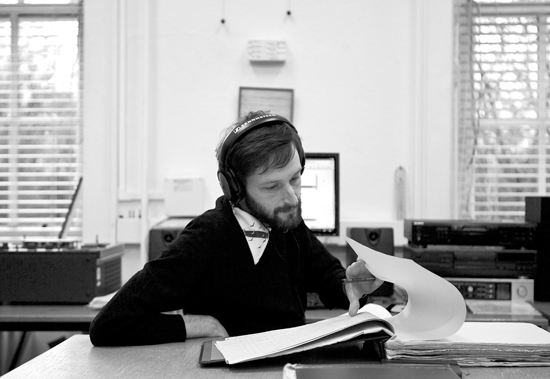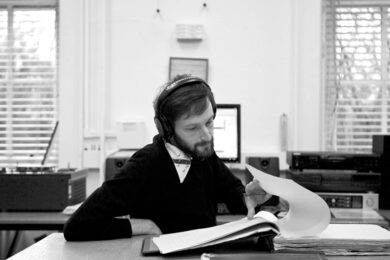The mid-twentieth century saw something of a rush to catalogue folk music and oral traditions around the world. Not only was it easier to record on the move, as portable tape recorders became more available, but there was a realisation that the great displacements of modernity had all but erased passed-down practices of song and storytelling.
In the 1950s Hamish Henderson, of the School of Scottish Studies (set up in 1951 at the University of Edinburgh), set out with the legendary American ethnomusicologist Alan Lomax to trace the sounds of Scotland, the songs and tales that, until that point, had been rarely, if ever, recorded. He and other collectors amassed the material that, sixty years later, musicians such as singer and songwriter Alasdair Roberts, vocalist and visual artist Aileen Campbell and Drew Wright, otherwise known as one-man folk-noise explorer Wounded Knee, would find when they recently took part in a residency at the School of Scottish Studies. They’re now taking the fruits of their research on tour around Scotland and England under the banner Archive Trails, put together by Edinburgh-based promoters Tracer Trails.
So, why work with a sound archive? Digitisation has put many public and academic archives at our fingertips, and listening to reams of song and speech online, as you can now with the British Library’s Sound Archive and Tobar An Dualchais (which contains recordings from major Scottish collections), is a thrilling and ghostly experience, inspiring for any musician. But sometimes, at least if you’re no expert in fiddle music or ballad form, it can feel lacking in context, the sound divorced from its origins. When artists study archival material to make new work such as Roberts’ Campbell’s and Wright’s, though, they can contextualise it again, put the life of the present back into these moments of preserved time and weave them into new and continuing traditions.
In this case, Aileen Campbell and Wounded Knee found themselves fascinated by the way researchers and informants interact in the field, as they listened in to the conversations caught on tape. Campbell, a member of the Glasgow Improvisors’ Orchestra, has made a new performance piece around the idea of song learning, which is usually done in private. Wounded Knee has taken on the role of an informant himself, exploring his own collection of songs and stories and delving into the rich language and lore of the fisheries of Scotland’s east coast. Alasdair Roberts, meanwhile, has been devising a theatre piece with Shane Connolly of Sokobauno Puppet Theatre, which is somewhat unexpected – I’ve seen Roberts perform many times over the last decade, solo and with various bands, but I don’t think puppetry has ever been involved. I email Roberts, who responds from Tobermory in the Isle of Mull, to find out more.
“Shane Connolly and I made puppets, a horse effigy, masks, a puppet booth and various props,” he says. “It’s the first time I’ve ever been so involved in that aspect of things, although Shane is a very experienced maker and puppeteer so it’s second nature to him. In a sense I was like his apprentice. Although the commission was for some new music, it was important for me to expand my own skills and experience into new areas – hence the physical, the visual, the theatrical elements of the work.”
Roberts and Connolly’s performance is a new version of Galoshins, a mummers’ play that Roberts tells me was performed in Scotland until the beginning of the 20th century.
“It was normally performed by groups of children – mostly boys of about eleven or twelve years old, going from house to house at Hallowe’en or Hogmanay. The plot is very simple – Bold Alexander introduces the action and acts as spokesperson; the Admiral and Galoshins are introduced one by one and fight with swords until Galoshins dies; then Doctor Brown enters and brings Galoshins back to life with a magical elixir. That’s the basic starting point.
“I’d come across it a few years previously and it had always been at the back of my mind to approach it artistically at some point in the future. I suppose I’m attracted to the basic, archetypal, perhaps primal nature of the play – it has the feeling of ritual and the power of myth, a certain symbolic quality which is, in my imagining, somewhat closer to the ancient ceremonial and ‘religious’ origins of theatre rather than whatever ‘theatre’ might mean in a modern Western sense. There’s the sort of Manichaean element, this struggle between two opposing forces, which has characterised other things I’ve worked on before, whether that’s individual songs, entire records, or other writings or creations.”
Roberts says that the School of Scottish Studies was supportive of the residency, and that the artists were made to feel welcome. “The SSS is obviously keen for awareness of its work to be raised, and I hope that our work can help in that regard,” he agrees when I ask about how, more generally, archives might benefit from having artists around – not least because next year sees the closure of the Museums, Libraries and Archives Council in the UK. Of course, Roberts is not a stranger to digging in the vaults – his last album, Too Long In This Condition, consisted of haunting, reworked traditional songs. His own songwriting, which on recent live appearances is developing into ever more epic metaphysical balladry, is infused with history and myth, language and belief. How does archival material inform what he does?
“During my visits to the School, I was able to attend some seminars and presentations by visiting academics on themes to do with folklore, oral traditions and other things which overlap with my own areas of interest," he says. "So that was very rewarding. I see my music in future developing compositionally but drawing on traditional materials, not just from Scotland but beyond, in the manner that composers have always done historically and which contemporary Scottish artists like, for example, Eddie McGuire, are currently doing. So in that sense, I see the kind of sonic material which the SSS sound archive holds as possible raw material, building blocks for future compositional work. It’s a pleasure to listen to the material in there, for enjoyment, edification and education… I’m a believer in osmosis, so I figure that exposure to all of those songs, tunes, singers, instrumentalists in the archive will no doubt enrich my own music in future.”
You can read the artists’ blogs at the Archive Trails website.
Tour dates:
Oct 19 : Rosehall, The Achness Hotel
Oct 23 : London, Cafe OTO
Oct 28 : Glasgow, CCA



